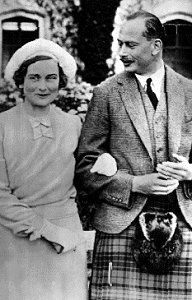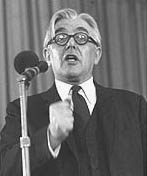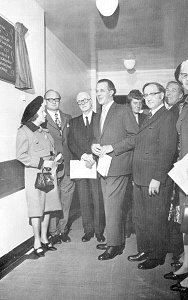|
|
|
The Bishop of Lichfield was the first person to sign the Royal Hospital's heavy leather bound Visitors' Book, which contains the signatures of royalty and also of a wife who met her husband when she was a cadet nurse. “Preached in chapel,” the Bishop wrote in the “Remarks” section on 4th February, 1917. The Great War was at its height when Wolverhampton's hospital got its new book. The second visitor to sign it was Lt. Col. Louis N. Harrison, officer commanding the 5th Northern General Hospital, Leicester. “I had the pleasure of opening the new military wards for wounded soldiers kindly provided by the citizens of Wolverhampton in response to a request from Headquarters, Northern Command, he wrote, on 8th June 1917. “I consider these admirably adapted for their purpose and wish to signify my appreciation of the promptitude and thoroughness which has been shown by the Board of Management in this action and their unfailing courtesy and kindness in carrying out all the detailed instructions of military administration.” The Mayoress of Wolverhampton, Mrs S.M.Wyatt, of Red Hill Lodge, Compton, was equally impressed with the soldiers' care on 18 December that year. “Visited the military wards, delighted with everything” was her verdict. During the next World War, the Royal itself was in the front line. Following the air raid on 31st July, 1942, the Earl and Countess of Harrowby came to see how things were. (There is now a Harrowby Road at Fordhouses.) The first page of signatures of staff from the 92nd Medical Gas Treatment Battalion, 640 U.S. Army is not dated but a second set of signatures from this unit does give the date of their visit, 12th March, 1944.
Among the mayors whose signatures appear are prominent businessmen in the town, L. R.Guy of Billingham's Motors and James Beattie of Beattie's. Neighbouring mayors and mayoresses and chairmen of district councils visited the patients on New Year's Day. Sir Winston Churchill's physician, Lord Moran, who played an important part in the doctors' negotiations over the introduction of the National Health Service as President of the Royal College of Physicians, met consultants at the Royal, with Sir Horace Hamilton, on 18th January, 1954.
He duly signed the Visitors' Book, but Wolverhampton's hospital seems to have made little impression on him. “I spent the day in Wolverhampton renewing acquaintance with a number of local authority people I met when I was Minister of Housing,” he wrote in his diary, end never mentions the Royal. “After an official opening of an old‑people's home and an official tour of a children's reception centre I was off.” The children's reception centre was Braybrook, at Wednesfield, named after Alderman Mrs A.A. Braybrook. Today commemorative railings mark its site. Where is Braybrook's Visitors' Book, which Crossman also signed?
MP Mrs Renee Short's is the only signature on the page for the “visit or Wolverhampton MPs to the new Linear Accelerator” on Friday, 21st October 1980. (A page with the title: `Visit of Mr Patrick Cormack, MP to Royal Hospital and New Cross Hospital on Friday 8th January 1971' is blank.) Patience Marshall heads the entries for the opening of the A.G.Marshall Room on 6 May 1982. The Deputy Commissioner for Jamaica came on 14 March 1967 ‑ Wolverhampton had now a sizeable Jamaican population. The Vice‑Lieutenant of the County of Stafford, Col. C.G.M.Boote, MBE, TD, presented Miss Rose Bradley with her MBE on 16 June 1973. His signature and the signatures of three others are on the page recording the event, but not Rose's. The last fifteen pages used in the book contain the most signatures and are the most moving. They record ordinary people, former patients, past and present members of staff, who attended the Open Day on 14th June, 1997, to commemorate 148 years of caring at the Royal Hospital and its closure. Stella Shorthouse, from Shareshill, was “a grateful patient.” Audrey Minett, from Codsall, writes of “special memories of the comfort of the chapel.” Kathleen Curtis has been a “Member of Hospital Friends for forty years (Chairman for 3 of them).” Roy Stallard, historian of Wolverhampton Hospitals Heritage and now leading the rear guard action to preserve the Eye Infirmary, returned as President of the Nurses' League and noted he trained at the Royal 1954‑57. Nurses express their gratitude. Vivian Hall gives “thanks to the Royal for a start to my career in the NHS.” Susan McAuster, from Wednesfield, “met my future husband whilst cadet nurse on Harper Miller Ward.” It is not only nurses and doctors who run hospitals and are emotionally attached to them. Joan Cox had “happy memories of 23 years in stores.” Edward West, Brownhills, was a general duties driver from 1954‑1960, and Janet Leek, Finchfield, had “happy memories of switchboard/Bed Bureau nights 1969‑91.” Tony Johnson felt the same about his work as a security officer. Claudine Weeks, of Tettenhall Road, sums up what the now empty Royal Hospital meant to so many: “A beautiful building which will always hold a place in Wolverhampton's heart.” The Vistors' Book had been bought when thousands were dying in the trenches of the Western Front in the Great War. It was purchased from William Gibbons and Sons, Ltd, Princess Street, Wolverhampton. In a slip in the final pages William Gibbons and Sons “respectfully request the favour of your order for a book to follow this.” “This notice,” it is explained, “is given to prevent the inconvenience arising from sufficient time not being allowed for the preparation of books that are wanted to follow in succession.” The repeat order never came. The “respectful request” lies lonely in the block of unused pages at the end of the volume. When New Cross replaced The Royal a hospital Visitors' Book was no longer needed. |





